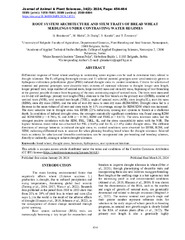| dc.description.abstract | Differential response of bread wheat seedlings to contrasting water regimes can be used to determine traits related to drought tolerance. The F1 offspring from eight crosses and 11 selected parental genotypes were simultaneously grown in hydroponic cultivation-polyethylene glycol (PEG) induced drought stress vs. control conditions. Criteria for selection of maternal and paternal genotypes were desirable traits in terms of increased tolerance to drought: longer stem length, longer primary root, large number of seminal roots, large root dry mass and stem dry mass, beginning of root branching at the greatest possible distance from beginning of the root,contrasting angle of seminal roots. The traits were measured on 14 day old seedlings: primary root length (PRL),distance to the first branch on the primary root (DFBR), number of seminal roots (NSR), total seminal root length (TSRL), angle of seminal roots (ASR), stem length (SL), root dry mass (RDM), stem dry mass (SDM), and the ratio of root dry mass to stem dry mass (RDM/SDM). Drought stress led to a decrease in the mean values of all root and stem traits by 11% on average, except for RDM/SDM which was increased. The most sensitive trait to drought stress was DFBR (25% reduction), causing root systems to branch at a shallower depth. In conditions of induced drought stress, the strongest statistically significant correlation was found among RDM and RDM/SDM (r = 0.794), SL and ASR (r = 0.708), RDM and TSRL (r = 0.673). The stress tolerance index had the strongest positive correlation with the SDM, PRL, TSRL, SL, and the stress susceptibility index with the NSR. The highest heterosis mean value was observed for PRL (24.6%) and for SL (15.6%) under drought stress. The different directions of average heterosis in induced drought stress vs. control conditions were observed for DFBR, RDM, and SDM, indicating differential traits to account for when planning breeding bread wheat for drought tolerance.Selected traits as criteria for selection and favorable combinations can be incorporated into pre-breeding and breeding schemes, directly or indirectly, aiming to achieve drought tolerance. | sr |


